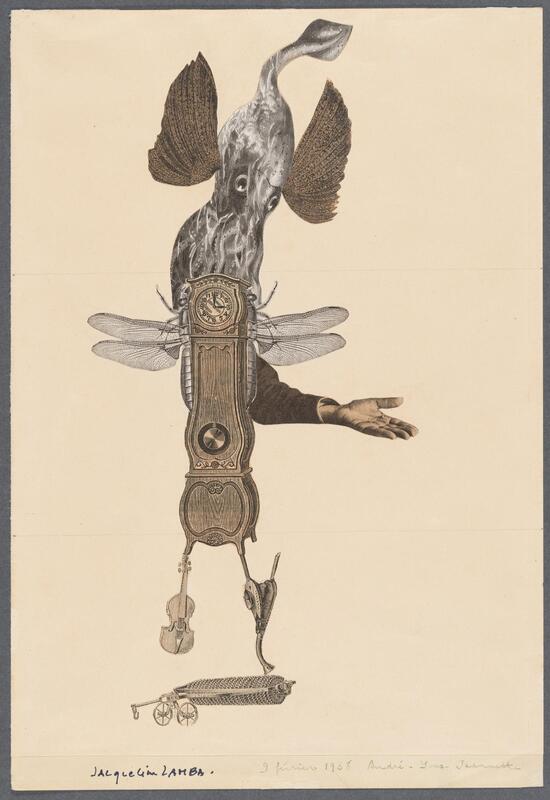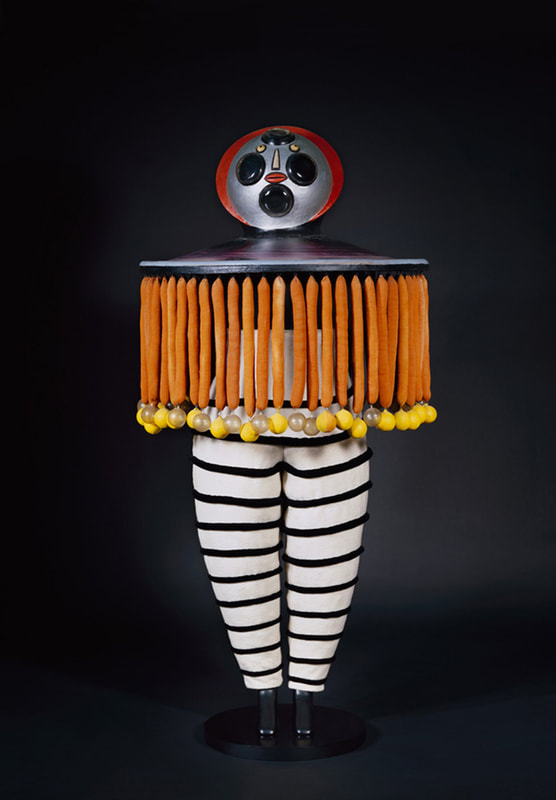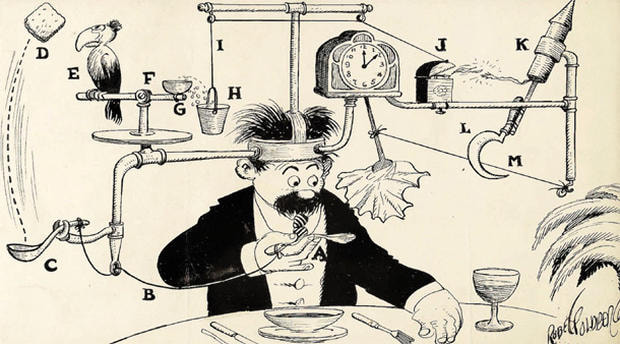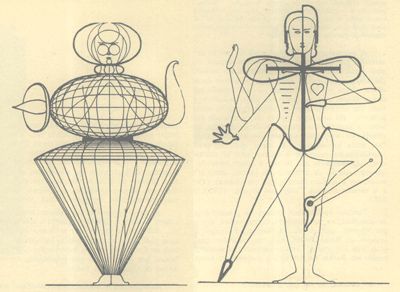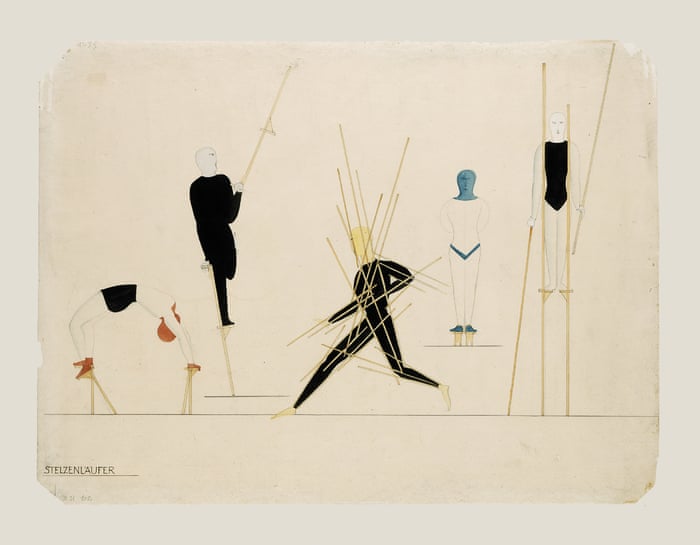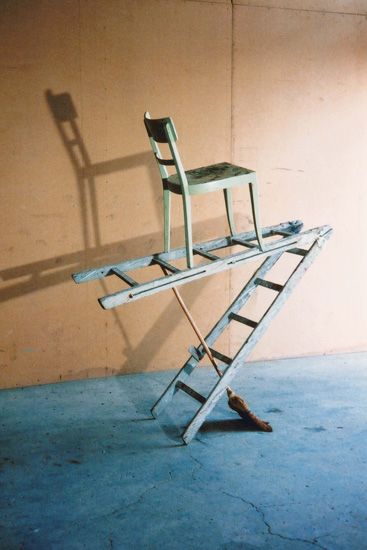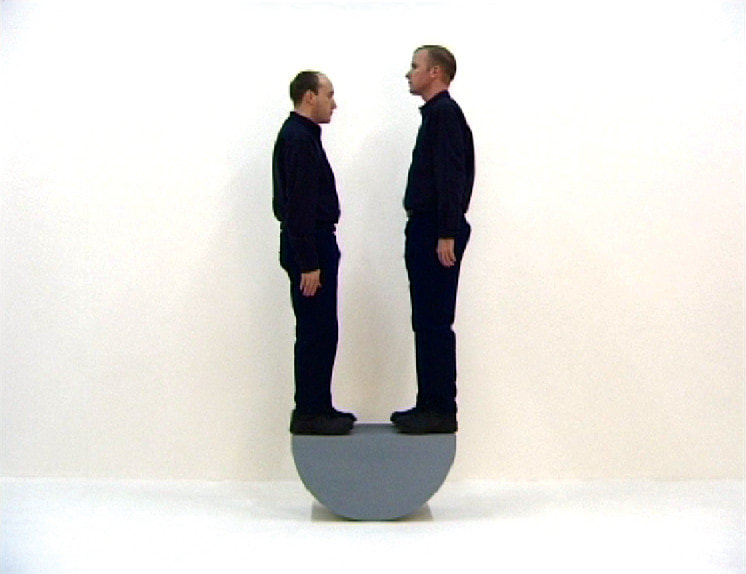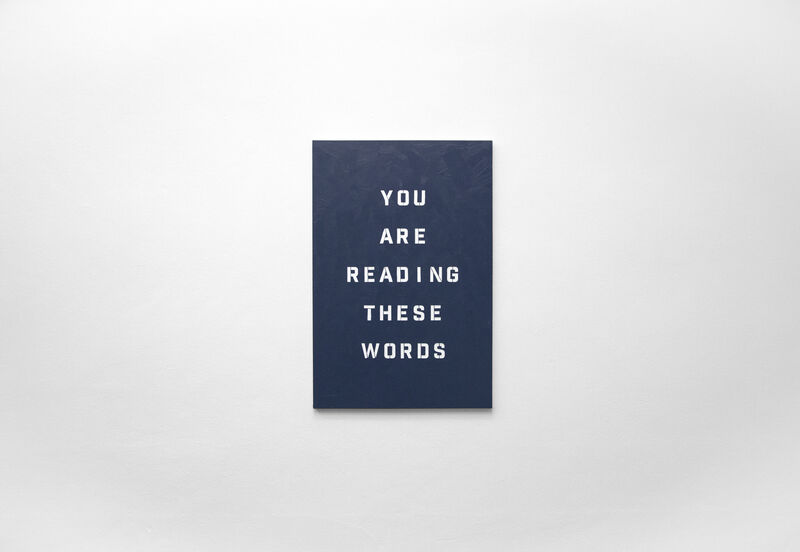TC#5: CRAFT, DESIGN & INVENTION - PLAYFUL, PURPOSEFUL, ABSURD
ABOUTThis resource has been designed for Year 8 teachers and students (Term 2) but is suitable for all ages. It links closely with Threshold Concept 5: Artists play, with materials, ideas and failure.
KEY THEMES
|
Politicians really should go to art school. Because one of the most important things you learn there is that you will make mistakes, you will be wrong, you will be wrong an awful lot of the time. And you learn that this is an essential thing, a natural thing, a wonderful thing. So, you might as well own up and own the mistake. HARRISON & WOOD
IN PICTURES
The images below have been chosen to encourage initial reflection. Consider them carefully and then use the following questions to help discussions. You might wish to research the titles/artist names to discover more - roll over the images to reveal these.
IN DISCUSSION
- How might you organise these 9 images into groups or collections (for example into 3 sets of 3). Consider categories such as 'traditional', 'Modern' or 'Contemporary'; or 'Art', 'Craft', and 'Design'. Or how about 'Playful', 'Purposeful' and 'Profound'? Which words are helpful/important to help you explain any connections?
- How would you explain the differences between 'Art', 'Craft', and 'Design', or even 'Artist', 'Craftsperson' and 'Inventor'? How about 'Traditional', 'Modern', and 'Contemporary'? How do the materials and/or techniques used help you to consider this?
- Which of these examples would you consider the most playful? (To answer this it might be helpful to do further research: remember that these are photographs of works rather than the works themselves, which might be sculptures, filmed 'performances', or something else).
- (How) do these works tell us something about the time and space within which they were created? Do they appear to be responses to - or for - something?
IN words
The following words might prove particularly beneficial to this project:
- Visual elements: line, shape, form, space, texture, surface.
- Design, craft, invention, function, purpose, sequence, motion.
- Kinetic, interactive, automata, hybrid, readymade, assemblage, surreal, performance, performative.
- Risk-taking, materials-led, purposeful play, ambiguity, absurdity.
In THE ARTROOM
The following slideshow and video clips support the sequence of lessons set out further below. Your teacher will provide further insights into specific tasks.
|
A short film on Al-Jazari's 13th century Elephant Clock with animated sequences showing how it worked.
|
A short film showing Henry Maillardet's The Draughtsman-Writer, ca. 1800, an automaton that can write and draw.
|
|
A short film showing The Bauhaus Movement's “Triadic Ballet,” by prodigious artist Oskar Schlemmer in 1922.
|
A short film with Rebecca Moss talking through a 2017 series. The example pictured further above, Thick-skinned, 2018 can be viewed here.
|
Inventive Play
The work of Ismail Al-Jazzari, above, shows a remarkable combination of art, design and engineering invention - even more so given that this was produced in the early 13th Century. Much of his work might be described as 'Automata' - mechanical devices that perform a sequence of designed and defined movements. This form of 'mechanical art' can be beautifully crafted, such as Henry Maillardet's The Draughtsman-Writer, but can also have an exaggerated purpose or be made simply for the fun of it. In this way it might also be comparable to Wallace & Gromit's cracking contraptions or Rube Goldberg's wacky illustrations, pictured below.
The work of Ismail Al-Jazzari, above, shows a remarkable combination of art, design and engineering invention - even more so given that this was produced in the early 13th Century. Much of his work might be described as 'Automata' - mechanical devices that perform a sequence of designed and defined movements. This form of 'mechanical art' can be beautifully crafted, such as Henry Maillardet's The Draughtsman-Writer, but can also have an exaggerated purpose or be made simply for the fun of it. In this way it might also be comparable to Wallace & Gromit's cracking contraptions or Rube Goldberg's wacky illustrations, pictured below.
- Using the TC5 'Artists play...' illustration as additional inspiration, draw/design/construct a mechanical device that might help an artist to play, imagine, invent and experiment (and/or fail!). Your design might use the elements that already exist within the TC5 illustration. E.g. 2 paintbrushes, a pencil, two containers, a tube, fire, water, bubbles etc. or alternatively, you might take inspiration from other objects in the art room or beyond. Your design might be totally absurd and impractical and exist as an imaginative drawing only. Alternatively, you might have a go at designing and constructing something in 3 dimensions that actually moves (or attempts to!).
Surreal and Material Play
Surrealism is a twentieth-century artistic movement that celebrated the irrational and the revolutionary. The Surrealists were fascinated with the unconscious mind and dreams. They invented and embraced a diverse range of approaches to art making including automatic drawing (drawing without conscious decision making, using free-flowing lines), collaging, and making 'sculptures' (or 'readymades', or 'assemblages') using unexpected and everyday materials and objects.
'Exquisite Corpse' was a collaborative game invented in 1925 in Paris by a group of Surrealists including André Breton and Marcel Duchamp. The game involves each player contributing to the development of a figure/form in sections (e.g. Head, body, legs, feet) without seeing the previous contributions of others.
|
|
This short video demonstrates how a game of Exquisite Corpse can act as inspiration for a playful sculpture experimenting with everyday materials. The sequence of images below shows how the game might also inspire collage, painting or even life-sized sculptures.
|
Although the Surrealists (and Dadaists too - a connected Art movement) might be most associated with playful and experimental methods of art making they are not the only artists to work in this way. Many creatives embrace collaborative or material-led' play as a means of creative stimulus.
Oskar Schlemmer was a German artist associated with the Bauhaus School where he worked as ‘Master of Form’. His most famous work is Triadic Ballet, which saw costumed actors transformed into geometrical representations of the human body in what he described as a "party of form and colour” using circles, triangles and squares. His costume designs might prove inspirational for playing Exquisite Corpse. However, alternatively ...
Oskar Schlemmer was a German artist associated with the Bauhaus School where he worked as ‘Master of Form’. His most famous work is Triadic Ballet, which saw costumed actors transformed into geometrical representations of the human body in what he described as a "party of form and colour” using circles, triangles and squares. His costume designs might prove inspirational for playing Exquisite Corpse. However, alternatively ...
- Develop your own playful/experimental costume design.
This might be inspired by Oskar Schlemmer (who was inspired by architecture and the movements of the human form in space). Alternatively, this might take a more contemporary influence, such as seen in Rebecca Moss's 'Thick-Skinned' video/performance which combines an interest in slapstick comedy with indirect social comment.
Your creative process might include: - a series of initial drawings, from your imagination, or using a figure in various poses.
- the development of more detailed costume designs, stylised illustrations and/or construction plans.
- the construction of a costumed figurine
- the development of an actual costume - perhaps for an individual or experimental group performance.
Drawings, designs, illustrations and photographs from Oskar Schlemmer's Triadic Ballet, 1922.
Whilst some artists, such as Oskar Schlemmer, above, balance a playful approach with systematic planning and development, other artists might work in more instant or intuitive ways with the materials they chose.
Huma Bhabha is a Pakistani-American sculptor based in New York, known for her uniquely grotesque, figurative forms often constructed with found materials such as Styrofoam packaging, wire, wood and clay. Her work addresses themes of colonialism, war, displacement and memories of home. Her influences are wide ranging, from ancient Egyptian statuary, African art, Classicism, Cubism and German Expressionism to science fiction and horror films.
The assembled, 'make-do' and combined textural qualities of Bhabha's work - and this sense of 'other-worldliness' - also bring to mind the work of Phyllida Barlow, a British sculptor who enjoys playing with materials and their 'resistances' and 'affordances' - what the materials might allow an artist to do, or not, and how this might lead from one decision to another.
Examples of both artists are shown below.
Whilst some artists, such as Oskar Schlemmer, above, balance a playful approach with systematic planning and development, other artists might work in more instant or intuitive ways with the materials they chose.
Huma Bhabha is a Pakistani-American sculptor based in New York, known for her uniquely grotesque, figurative forms often constructed with found materials such as Styrofoam packaging, wire, wood and clay. Her work addresses themes of colonialism, war, displacement and memories of home. Her influences are wide ranging, from ancient Egyptian statuary, African art, Classicism, Cubism and German Expressionism to science fiction and horror films.
The assembled, 'make-do' and combined textural qualities of Bhabha's work - and this sense of 'other-worldliness' - also bring to mind the work of Phyllida Barlow, a British sculptor who enjoys playing with materials and their 'resistances' and 'affordances' - what the materials might allow an artist to do, or not, and how this might lead from one decision to another.
Examples of both artists are shown below.
The examples on the top row are by Huma Bhabhpa. The ones below are by Phyllida Barlow. These are two different 'contemporary' artists with different experiences and intentions, and yet the works also seem to share similarities, not least a certain playfulness with material properties.
- Develop a small maquette/sculpture that utilises found and scrap materials, natural and/or man-made. Try to work in a way that is intuitive and responsive to the properties of the materials (how they feel, join, flex, distort, and so on; but also their form, colour, tone, texture etc.). Try not to worry about it looking like something recognisable. Instead, assemble and combine to create something more unexpected or peculiar yet somehow resolved, complete, satisfying.
Playful partnerships
For a more instant and 'readymade' approach to material-led play, the work of Fischli and Weiss can provide playful inspiration. Their series, Equilibres / Quiet Afternoon, shows precariously balanced sculptures made from everyday items at what appears to be the exact moment before their collapse.
The assemblages do not simply look temporary; once photographed, they were disassembled, and so the photographs are the only record of their existence.
- Develop your own experimental 'Equilibres' - combinations of carefully balanced objects to be photographed. Be mindful of your choices of objects - so this is a safe exercise, obviously, and nothing isn't broken that shouldn't be. But also, be aware of how your choices influence this 'composition in space' (and the photograph of it). You might consider how different objects will contrast, be it in expectations, colour or form.
Comparable to Fischli and Weiss (top row of images, above), is the work of John Wood and Paul Harrison (bottom row of images, above). This also provides an example of a playful partnership between artists. Their video work, also inspired by slapstick comedy, often experiments with balance and tension of objects (and their own bodies) in space, and before a camera lens.
|
|
This video shows some insights into the work of Harrison and Wood. Consider the following questions:
|
BEING CLUELESS CAN BE A GOOD THING, IT CAN BE KIND OF EXCITING. BUT WE ALSO HAVE A COLLECTIVE CLUELESSNESS. BEING CLUELESS CAN BE A BAD THING, IT CAN BE KIND OF FRUSTRATING.
DRAWING IS ONE WAY WE GIVE OURSELVES AND EACH OTHER A CLUE. WHEN WE HAVE SOMETHING ON OUR MIND, WE DRAW IT OUT AND WE DRAW IT OUT. HARRISON & WOOD
Read the quote, above, by Harrison and Wood. In this quote they acknowledge that drawing can help them to problem solve and understand. As with their approach to their video work, Harrison and Wood's (often text-based) drawings also embrace a certain absurdity and playfulness that goes against expectations. Below are a few examples:
- How might you develop a playful and profound response using only a pencil and a4 sheet of paper? This might involve drawing, writing or sculpting with the paper and/or pencil in less expected ways.
- How might you create an artwork using a pencil that doesn't involve drawing at all?
FURTHER READING
- The History of Automata - Mechanical Art & Design Museum resource
- Oskar Schlemmer's ballet of geometry - Guardian, In pictures
- Maillardet's Automaton - The Franklin Institute resource
- Nobody did costumes like the Bauhaus - Curbed article
- John Wood and Paul Harrison: Why we draw - Phaidon article





